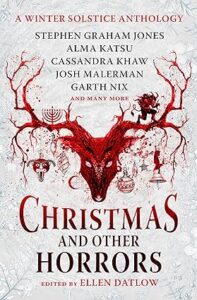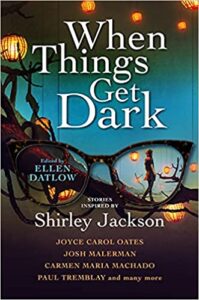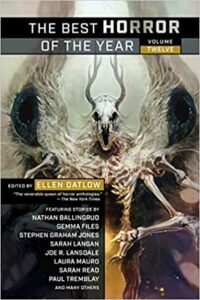Christmas and Other Horrors:: An Anthology of Solstice Horror edited by Ellen Datlow
Titan Books, 2023
ISBN-13 : 978-1803363264
Available: Hardcover, Kindle edition, audiobook
Buy: Bookshop.org | Amazon.com
Many people think of the Christmas season as a cheerful time of year, but it’s always been a time where sprits, gods, and terrifying creatures roam. Ghost stories set at Christmas abound: Charles Dickens and M.R James both published them every year. Coinciding with the winter solstice, it’s also a time of sacrifice. Christmas and Other Horrors draws on this tradition, with a wide variety of stories, ranging from folk horror to apocalyptic clifi.
There are several stories I found especially enjoyable.
In “The Importance of a Tidy Home,” ,by Christopher Golden, grotesque creatures local to Salzburg, Austria murder residents of homes that haven’t been tidied for the new year;
“The Ghost of Christmases Past”, by Richard Kadrey, describes Christmas Eve with Laura, who boards herself into her house every year to prevent the return of a cannibalistic witch who ate her brother in front of her, to her husband’s disbelief;
“All The Pretty People” by Nadia Bulkin, describes a Festivus party reuniting college friends, who are surprised when their friend Sam, who ghosted them months ago, arrives
“Cold”, by Cassandra Khaw, is an apocalyptic clifi story in which a saint, Brede, arrives every year on the winter solstice, asking if she can stay and sleep until spring… but what happens when spring doesn”t come? The figurative language and world-building in this story were fantastic.
In “Löyly Sow-na”,by Josh Malerman, Russell visits his Finnish girlfriend Hannele’s family, where he is trapped in a sauna with her father. I had no idea how this story was going to play out!
“Grave of Small Birds”, by Kaaron Warren, is a folk horror tale in which a bad-tempered reality show chef specializing in medieval cookery takes a job on a small British island with strange Christmas traditions. While it was fairly predictable, the setting was well-done. The main character was unlikable, so I found the ending very satisfying. This was a very atmospheric story, and descriptions of the island and its unusual traditions were excellent..
While the winter solstice and the Christmas season have passed, I can recommend this book for any time of year.
Reviewed by Kirsten Kowalewski







Follow Us!